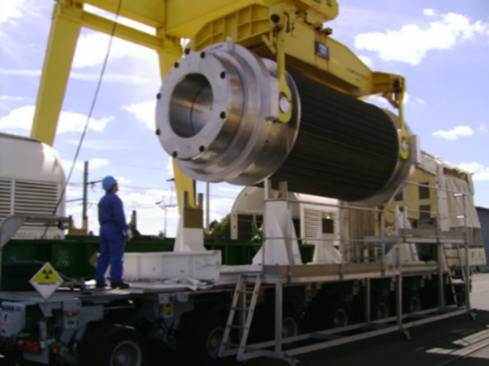
Fuel Transport & Storage Solutions for SMR/AMR
<table><tbody><tr><td>Implement a comprehensive program for successful transport for both the front-end and back-end of the fuel cycle as well as interim storage</td></tr></tbody></table>
-
- Address the wide range of reactor designs, relying on different fuel types or modules (varying in geometry, chemical composition, enrichment, fissile materials, as well as targeted burn-up levels), by developing new customised solutions
- Support, within constrained timeframes, the delivery of fresh fuel to reactor sites around the world
- Manage the initial storage and transport of spent fuel, pending either their future reprocessing or long-term interim storage in an open fuel cycle
-
1. Front-End Transport Solutions
- For LEU: DN30 for UF6, TNF-XI for UO2 powder.
- For LEU+ or HALEU-enriched UF6: adopt innovative solutions such as DN30-X (approved to transport LEU+ and HALEU UF6) and VP55
- For HALEU (UO2 or U3O8, Umetal, TRISO…): apply VP55
- Pu (MOX/salts): deploy FS47 and MX6
2. Back-End Transport Solutions
- For your transport needs: use the TN MW®, a modular triple-purpose (transport/interim storage/final disposal) small/medium cask solution, or the TN Eagle®, a modular dual-purpose (transport/interim storage) cask solution
- Or opt for the reuse of existing casks (TN®MTR, TN®17MAX…)
3. Interim Dry Storage Solutions
- Select metallic cask solutions such as TN MW or TN Eagle
- Implement concrete Multi-Purpose Canister solutions such as Nuhoms Matrix
-
- Take advantage of the latest modular cask concepts to ensure flexibility for nuclear operators and simplify the licensing process.
- Reuse existing casks as an optimized solution to manage costs and leverage proven technologies for the initial stages of SMR/AMR development.
- Enhance safety and robustness through optimised designs that also reduce manufacturing lead times and costs.
- Provide competitive solutions by pooling efforts among stakeholders to avoid specific developments for each SMR/AMR project.
